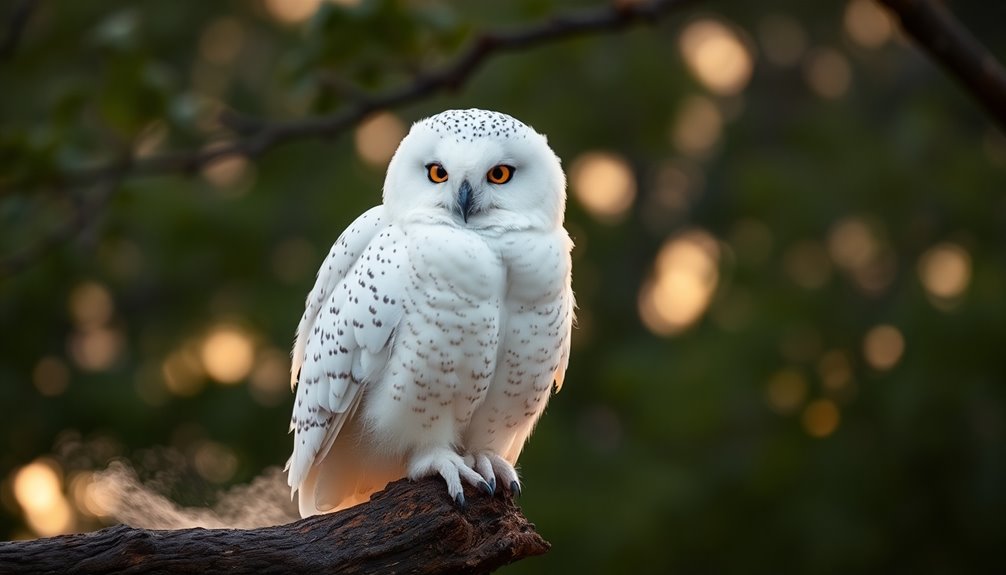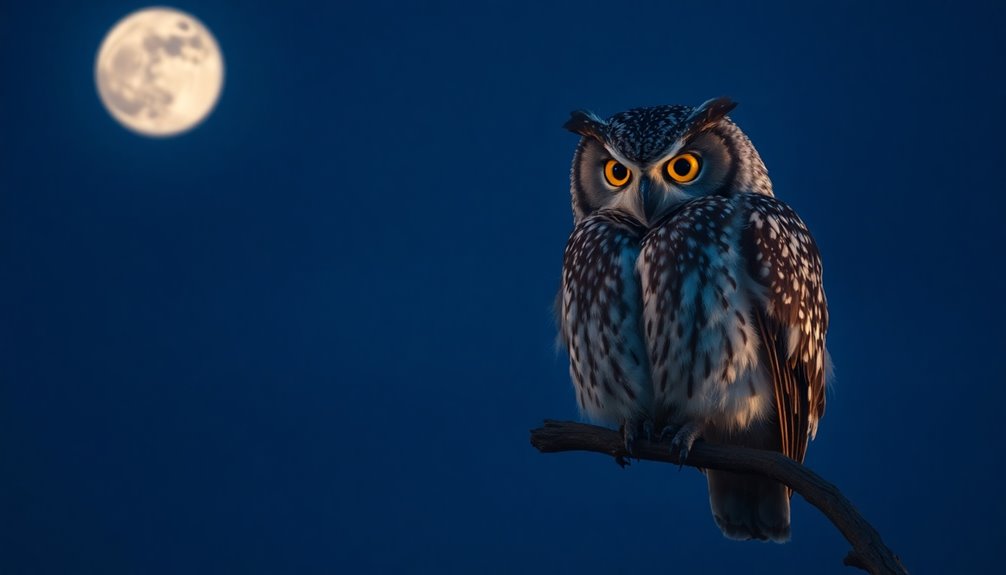Deer symbolize many wonderful things, like gentleness, transformation, and spiritual guidance. In different cultures, they represent love, connection, and adaptability. For instance, Native Americans see deer as messengers from the spirit world, while in Buddhism, they symbolize peace and compassion. Deer also remind us to embrace inner growth and personal change. They often appear in stories and art, evoking calmness and beauty. When you encounter a deer, it might encourage you to reflect on your feelings or connect with nature. So, keep exploring this fascinating topic to discover even more about the rich symbolism of deer!
Key Takeaways
- Deer symbolize fertility, love, and connection across various cultures, acting as spiritual guides during important life changes.
- In Celtic mythology, deer represent sacredness, embodying both feminine grace and masculine strength, often associated with transformation and adaptability.
- Deer are seen as symbols of purity and divine care in Christianity, guiding individuals toward deeper faith and spiritual insight.
- Encounters with deer promote emotional healing, patience, and introspection, encouraging self-reflection and nurturing connections with others.
- Artistic depictions of deer often highlight themes of renewal, innocence, and the beauty of nature, captivating audiences and emphasizing moral lessons.
Cultural Symbolism of Deer

When you explore the cultural symbolism of deer, you'll find that these graceful creatures hold significant meanings across various traditions.
In Native American cultures, deer symbolizes fertility and love, acting as messengers from the spirit world. They remind you of the beauty of connection and caring for one another.
In Celtic mythology, deer symbolizes sacredness, representing both feminine grace with Eilid and masculine strength with Damh. This duality shows how powerful and gentle these animals can be.
In Christianity, deer symbolizes devotion and divine care. They embody spiritual purity and reflect the light of Christ, guiding you toward a deeper faith.
The Huichol tradition sees deer as powerful spiritual guides. They emphasize kindness and unity with nature, teaching you to approach life with softness.
Buddhism links deer with peace and harmony. They symbolize the importance of compassion, especially since the Buddha preached his first sermon in Deer Park.
Across these cultures, you can see that deer symbolizes love, strength, and spiritual guidance.
It's fascinating how one creature can carry so many meanings, inviting you to reflect on your own connections with nature and the world around you!
Spiritual Significance in Religions
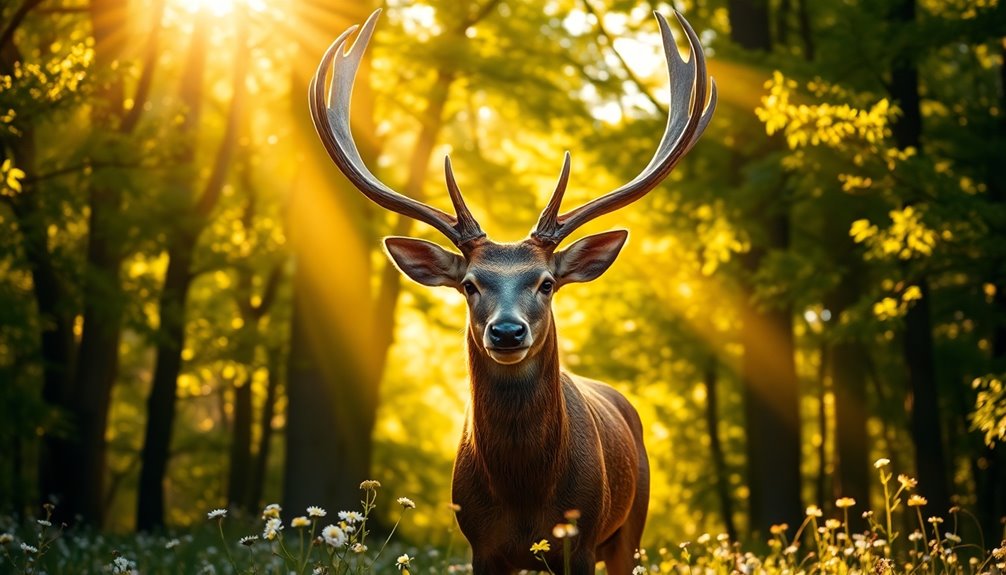
Let's explore how different religions see the deer as a special symbol!
In Christianity, deer show God's care, while in Buddhism, they represent peace and harmony.
Native American beliefs also honor deer, seeing them as messengers of love and kindness.
Christianity's Deer Symbolism
Deer hold profound symbolism in Christianity, representing a deep connection between believers and the divine. In the Bible, deer represent a longing for God, as seen in Psalms 42:1, where it compares the soul's thirst for the Lord to a deer thirsting for water. This imagery highlights how you can seek comfort and strength in your faith.
The story of Saint Eustace also showcases how deer can be transformative. In this legend, a deer leads him to a spiritual awakening. This shows that deer represent divine messages and guidance, reminding you to stay open to spiritual insights.
Moreover, deer eyes are seen as symbols of the light of Christ. They reflect purity and a deeper understanding of your spiritual journey.
When hunting deer is abandoned in Christian contexts, it signifies a shift toward compassion and love, aligning with themes of sacrifice and redemption.
2. Buddhist Teachings on Deer
The symbolism of deer extends beyond Christianity, finding profound meaning in Buddhism as well. In this tradition, deer represent harmony, peace, and the gentle qualities of compassion. They remind you of the ideals of the Dharma. The male and female deer, often shown beside the Dharma wheel, symbolize the balance of wisdom and compassion in Buddha's teachings.
One of the most famous stories is about the golden deer. This tale emphasizes purity and serenity, teaching you to live a life free from fear and attachment. Deer also hold a special place in Buddha's first sermon at Deer Park, marking a crucial moment in Buddhist history.
Here's a quick look at how deer embody these teachings:
| Symbol | Meaning | Deer Spirit |
|---|---|---|
| Harmony | Promotes peaceful living | Guides you through life's challenges |
| Compassion | Encourages kindness to all | Inspires gentleness |
| Wisdom | Navigates problems gracefully | Represents clarity in thought |
Embracing the deer spirit can help you cultivate these beautiful qualities in your own life!
3. Native American Beliefs
In many Native American cultures, the deer holds deep spiritual significance, symbolizing love, kindness, and gentleness. You might find it fascinating that deer often act as messengers from the spirit world. They guide people during important life changes, helping them make wise decisions. The white-tailed deer is especially cherished in Cherokee spirituality. It's seen as a symbol of good luck and plays a central role in many rituals and ceremonies.
When Native Americans hunt, they emphasize respect for the deer. They believe it's essential to honor the spirit of the deer for its sacrifice. This practice highlights the idea that all living beings are interconnected, reminding you of the significance of empathy and compassion.
The antlers of the deer also carry special meaning. They represent growth, regeneration, and even fertility. These themes are fundamental in Native American beliefs, reflecting a deep relationship with nature.
Representation in Art and Literature
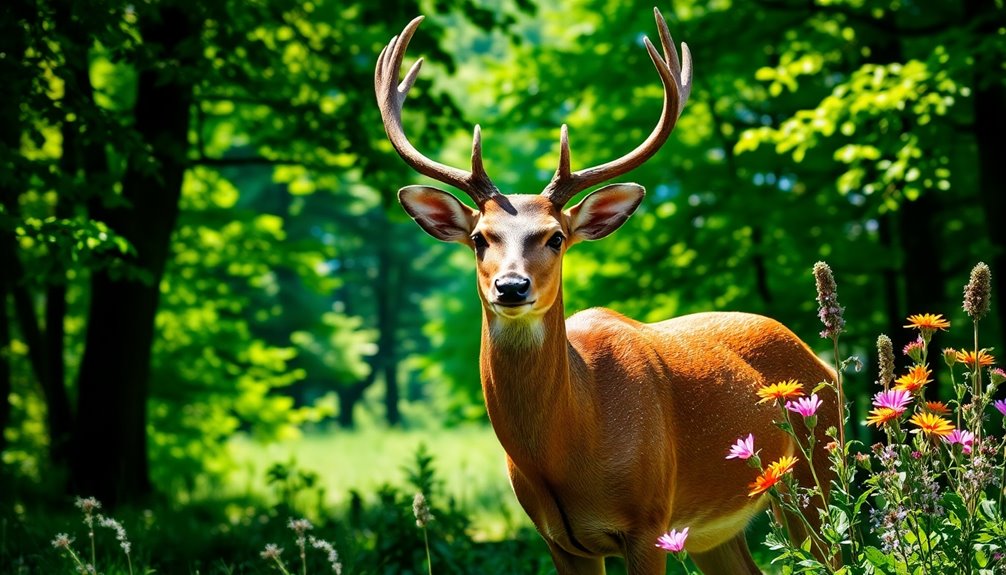
When you think about deer in art and stories, you can't help but notice how they symbolize purity and innocence.
These gentle creatures often represent themes of transformation, showing us how characters grow and change throughout their journeys.
Plus, in folklore, deer take on magical roles, guiding heroes and adding a sense of wonder to the tales we love.
Symbol of Purity
While many animals symbolize different traits in art and literature, deer stand out as powerful representations of purity and innocence. Artists often depict these graceful creatures in serene natural settings, creating an atmosphere of peace and tranquility. The white-tailed deer, in particular, shines as a symbol of purity, reflecting nature's beauty and untainted spirit. When you see a deer in art, it usually evokes a sense of calmness and harmony.
In literature, deer serve as metaphors for vulnerability and grace. Characters who embody these traits often undertake journeys of personal growth, reminding us of the importance of staying true to our intentions. Just like deer shed their antlers, they also symbolize renewal and new beginnings.
You might even notice deer in spiritual and healing art. Here, they reinforce themes of purity, suggesting a connection to the divine. Tattoos featuring deer often highlight their gentle nature, symbolizing a deep bond with nature and the purity of one's emotions.
Themes of Transformation
Deer embody themes of transformation across various artistic and literary landscapes, showcasing their remarkable ability to adapt and evolve. In many stories, deer symbolize change and growth. For example, in Celtic myths, they can shapeshift into women to escape hunters. This clever trick shows how adaptable they truly are!
Artists often paint deer in peaceful scenes, surrounded by nature. This creates a sense of calm and purity, reflecting the idea that transformation can be serene.
When deer shed their antlers, it represents renewal and the cycle of life. As new antlers grow, it reminds us that we can change and grow too!
In fantasy tales, deer appear as magical guides who help characters on their journeys. They symbolize the power of nature and intuition, encouraging self-discovery.
When a deer appears in a story, it often signals a character's inner growth and new beginnings.
Depiction in Folklore
Throughout various folklore traditions, the deer often emerges as a symbol of purity and innocence, enchanting audiences with its graceful presence. In many Native American stories, deer are often depicted as gentle and kind creatures, highlighting their deep connection to nature. This connection brings a sense of peace and harmony to the tales they inhabit.
In Celtic mythology, deer are often seen as mystical beings, acting as messengers between our world and the supernatural. They symbolize transformation and shapeshifting, adding a layer of magic to the stories.
In literature, deer are often used as metaphors for our own experiences. They represent themes of vulnerability and emotional healing, reminding us of the importance of nurturing our instincts.
Artistic depictions of deer capture their elegance and beauty, making them popular subjects for healing art and tattoos. People choose these designs to express a strong bond with nature.
In fantasy tales, deer are often imagined as magical creatures or spirit guides. They symbolize guidance and protection, helping characters on their life journeys. The enchanting presence of deer in folklore truly brings joy and inspiration to our imaginations!
Emotional and Psychological Associations
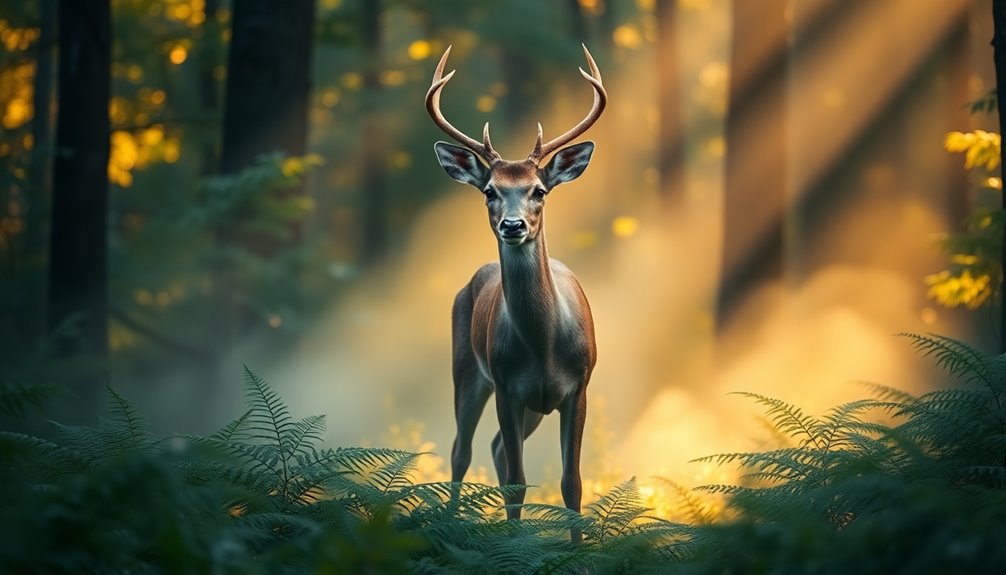
When you come across the symbolism of a deer, it often brings to light emotional healing and self-care. These gentle creatures remind you to nurture yourself and be open to love and compassion. Their presence encourages qualities that help you connect with others and understand their feelings better.
Here are some emotional and psychological associations of deer:
- Emotional Healing: Deer symbolize the journey toward emotional recovery, urging you to take care of your heart.
- Patience and Understanding: They promote gentleness and empathy, which helps in building strong relationships.
- Introspection: Seeing a deer in your dreams may signal a need for self-reflection, helping you understand your feelings better.
- Connection to Nature: Encountering deer can create a sense of peace and tranquility, enhancing your emotional well-being.
Deer also represent vulnerability, reminding you to embrace your gentle side.
As you navigate your emotional experiences, don't forget to nurture that instinct within you. Embracing these qualities can lead to deeper connections with yourself and others, making your journey through life even more fulfilling.
Deer as Spirit Animals
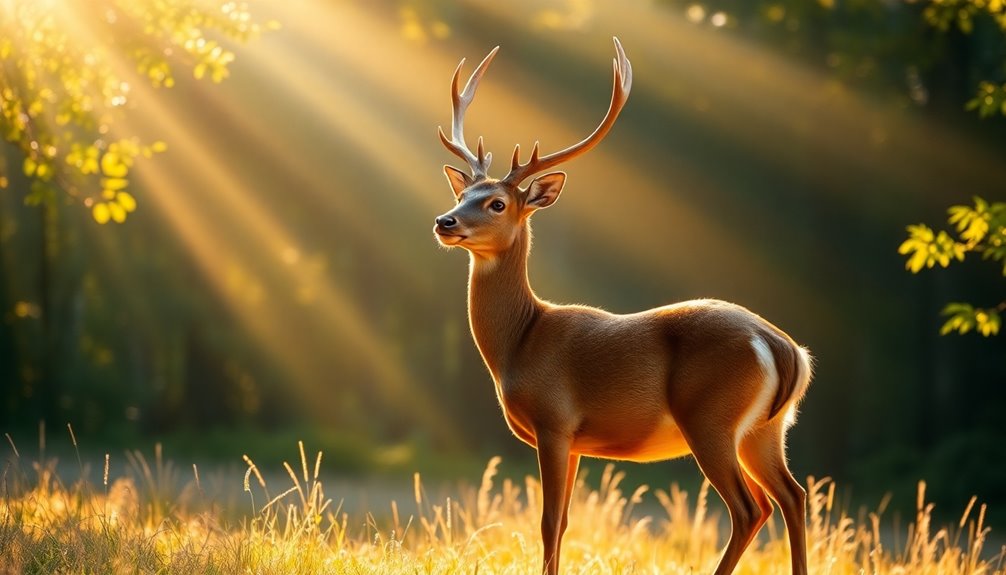
Embracing the emotional and psychological qualities associated with deer naturally leads to exploring their role as spirit animals. When you think of deer as spirit animals, picture gentleness and sensitivity. These beautiful creatures encourage you to nurture your compassionate side and connect with your inner softness.
Deer are often seen as messengers from the spirit world, guiding you to reflect on your life path. They remind you to find harmony with nature and trust your instincts. This trust can lead to personal growth and transformation, helping you discover new strengths.
In many cultures, deer as spirit animals represent a balance between strength and vulnerability. They teach the importance of being assertive while staying gentle in your interactions with others. This balance is essential in forming healthy relationships.
Deer spirit animals also inspire emotional healing and self-reflection. They urge you to nurture your connections and cultivate peace and understanding in your life.
Dreams and Encounters With Deer
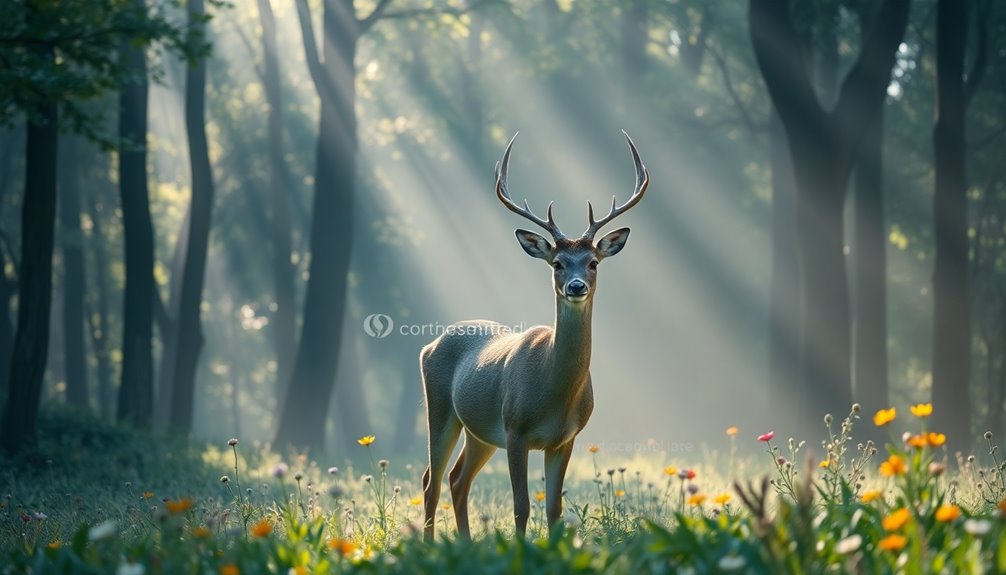
Dreams and encounters with deer can carry profound significance, often revealing insights about your emotional state and personal journey. When you see a deer, whether in dreams or real life, it's usually a positive sign. Here are some key points to contemplate:
- Emotional Healing: Encountering a deer invites you to embrace gentleness and compassion.
- Self-Reflection: Dreams featuring deer often signal a need for introspection and emotional awareness.
- Inner Conflict: If you're chased by a deer in your dream, it might point to unresolved fears or conflicts you need to address.
- Love and Kindness: The presence of deer encourages you to open your heart and nurture your relationships.
When you dream about deer, they can act as gentle reminders to connect with your true path.
Seeing them frequently nudges you to be mindful and appreciate nature.
Remember, these encounters aren't just random; they bring messages from your subconscious that can guide you on your journey.
Lessons From Deer Symbolism
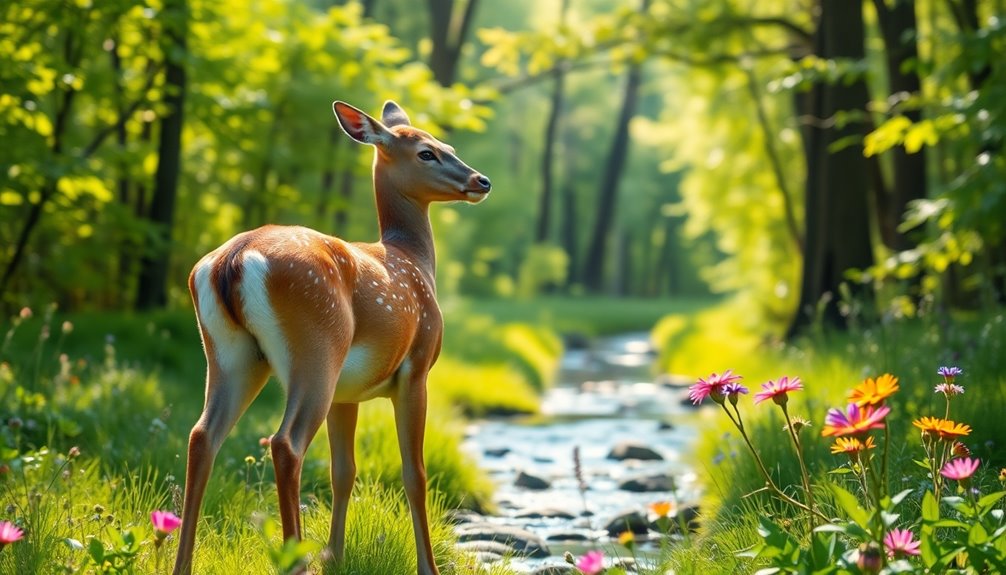
Deer symbolize a profound connection to the natural world and offer valuable lessons for maneuvering life's complexities. One key lesson from deer is the importance of enjoying life and being present. You can learn to appreciate the beauty around you, just like deer do in their peaceful habitats.
Deer also teach you about balance. They show you that it's crucial to be gentle but assertive when facing challenges. In life, combining these traits can help you navigate tricky situations more smoothly.
Another important lesson is to connect with nature. Deer inspire you to be aware of your environment and respect the ecosystems that nurture us all. This connection can lead to personal growth, encouraging you to expand your perceptions and embrace new experiences.
Lastly, deer remind you to act according to your personal truths. It's imperative to trust yourself and be authentic in your decisions and interactions.
Practical Actions When Deer Appear

When you encounter a deer, it's a moment that invites reflection and connection.
These gentle creatures can bring powerful messages to your life. Here are some practical actions you can take to embrace the experience:
- Pause and Reflect: Take a moment to soak in the sight. What feelings or thoughts come up for you?
- Practice Mindfulness: Focus on the deer's gentle energy. This can help you feel more connected to nature and yourself.
- Journal Your Thoughts: Write about the encounter. Explore themes like trust, love, and personal growth that the deer might inspire.
- Meditate or Contemplate: Find a quiet space to center yourself. Think about the peaceful qualities of the deer and how you can bring those into your life.
Frequently Asked Questions
What Does a Deer Symbolize Spiritually?
A deer symbolizes gentleness and grace, reminding you to embrace your softer side.
In many cultures, it represents harmony and peace, encouraging you to nurture your connections.
When you see a deer, think of renewal and new beginnings, as they shed their antlers each year.
This powerful message can inspire personal growth and emotional healing.
What Is a Deer a Metaphor For?
A deer is a metaphor for grace and gentleness. When you think of a deer, you might picture its soft movements and delicate presence. This reminds you to embrace kindness and sensitivity in your own life.
Deer also symbolize vulnerability, urging you to show compassion for others. Plus, their ability to grow new antlers each year inspires you to accept change and seek personal growth.
Isn't that a wonderful reminder for us all?
Which God's Symbol Is a Deer?
You might be surprised to learn that many gods have a deer as their symbol! For example, Artemis, the Greek goddess of the hunt, treasures the deer, representing purity and grace.
In Celtic mythology, Cernunnos, the god of nature, is often linked to stags, symbolizing strength and protection.
Additionally, in Hindu beliefs, the goddess Saraswati connects with red deer, showcasing wisdom and creativity.
Isn't it fascinating how these symbols tell us so much about each god?
What Is the Deer Symbol in Astrology?
In astrology, the deer symbolizes gentleness and intuition.
If you're connected to this energy, you might find yourself nurturing others and showing compassion in your relationships. You embrace your instincts, helping you grow personally and heal from challenges.
The deer teaches you to balance being gentle with being assertive. With grace and elegance, you can inspire those around you, making you a natural leader.
Isn't it exciting to think about how this energy influences you?
Conclusion
To sum up, deer symbolize many wonderful things, like gentleness, intuition, and connection to nature. Did you know that there are over 60 species of deer around the world? That's a lot of different kinds! Whether you see a deer in the wild or dream about one, remember their special meanings. They remind us to be kind, stay curious, and appreciate the beauty around us. So, keep your eyes open for these graceful creatures and their inspiring messages!






